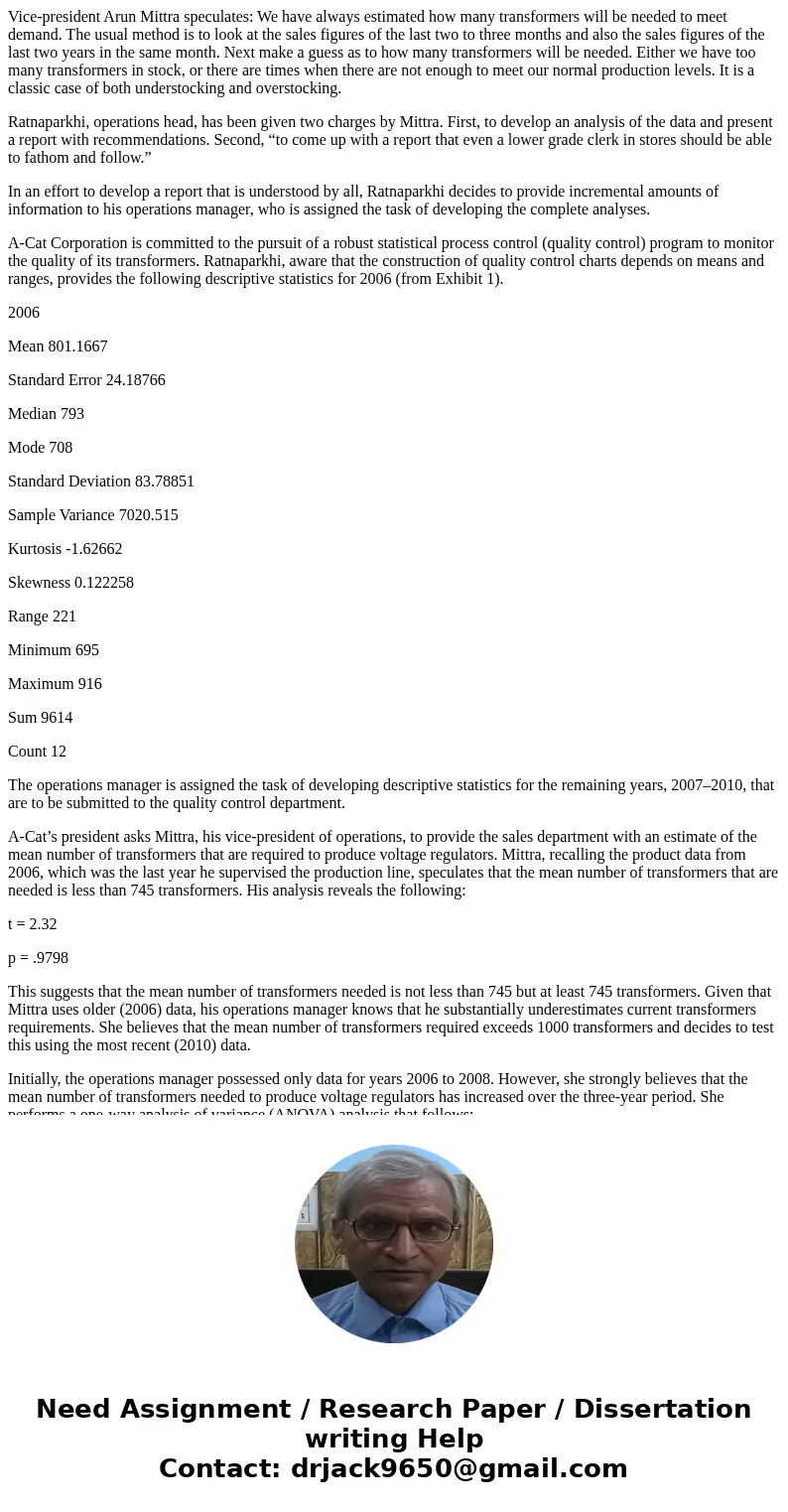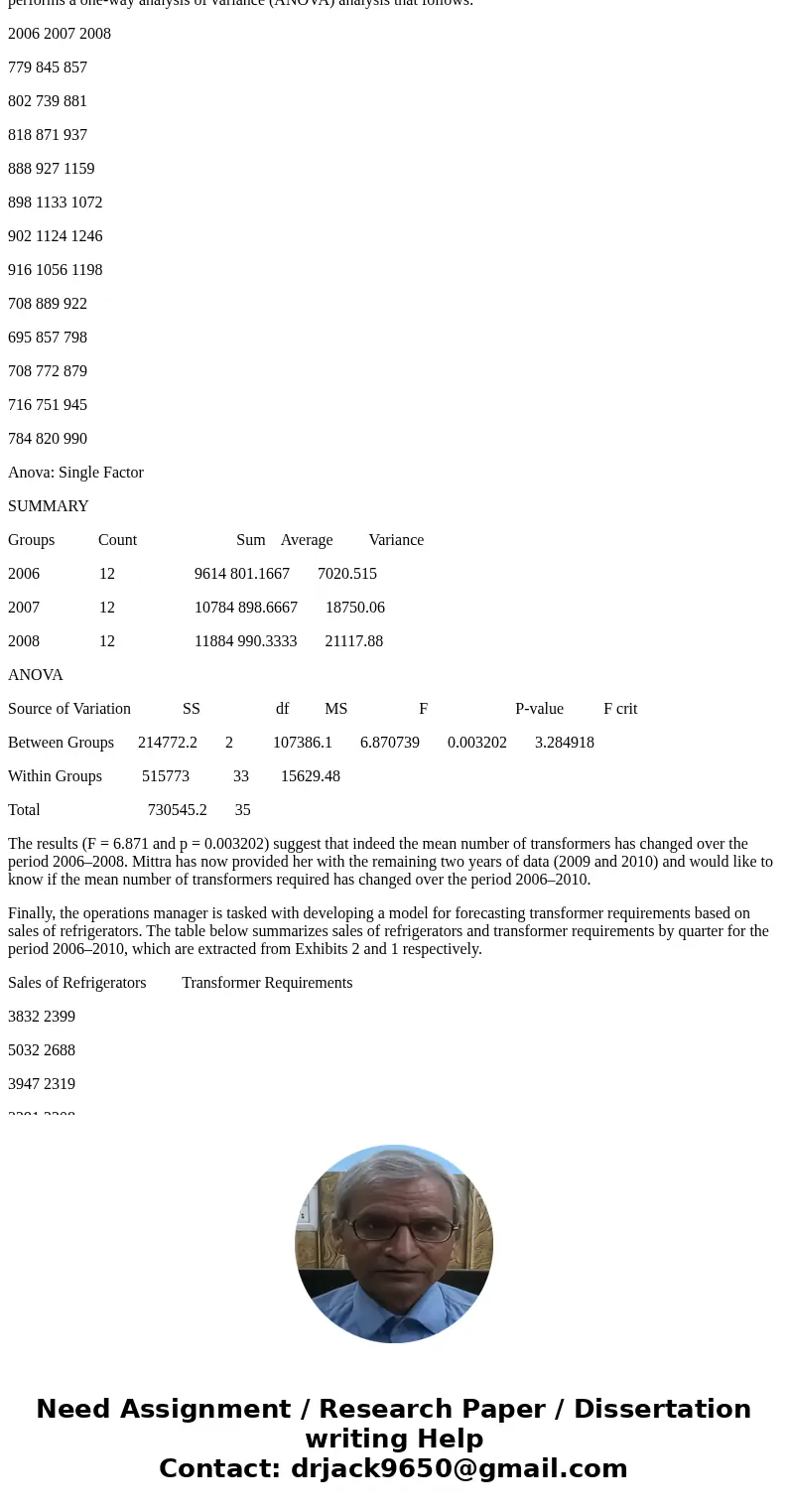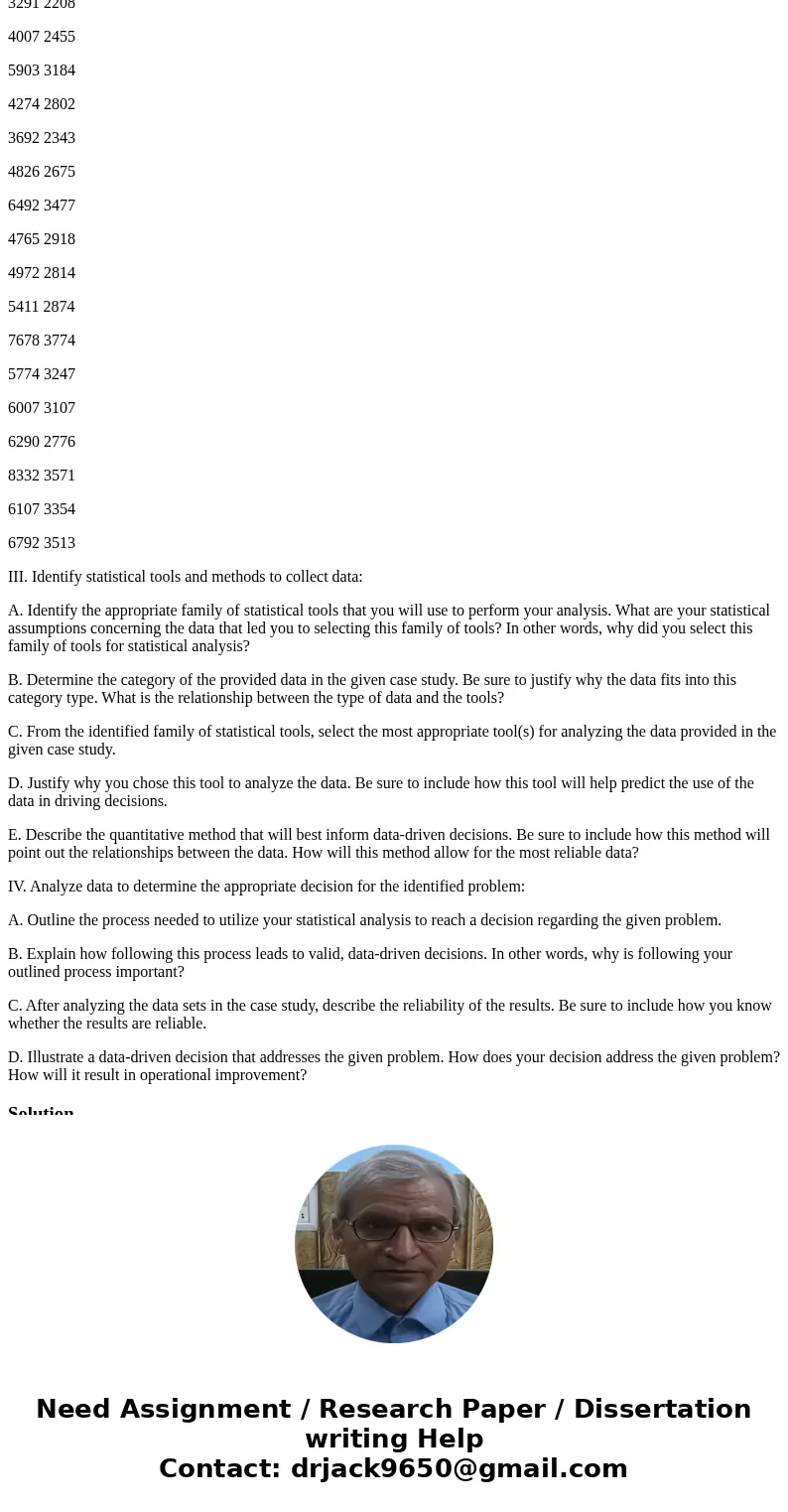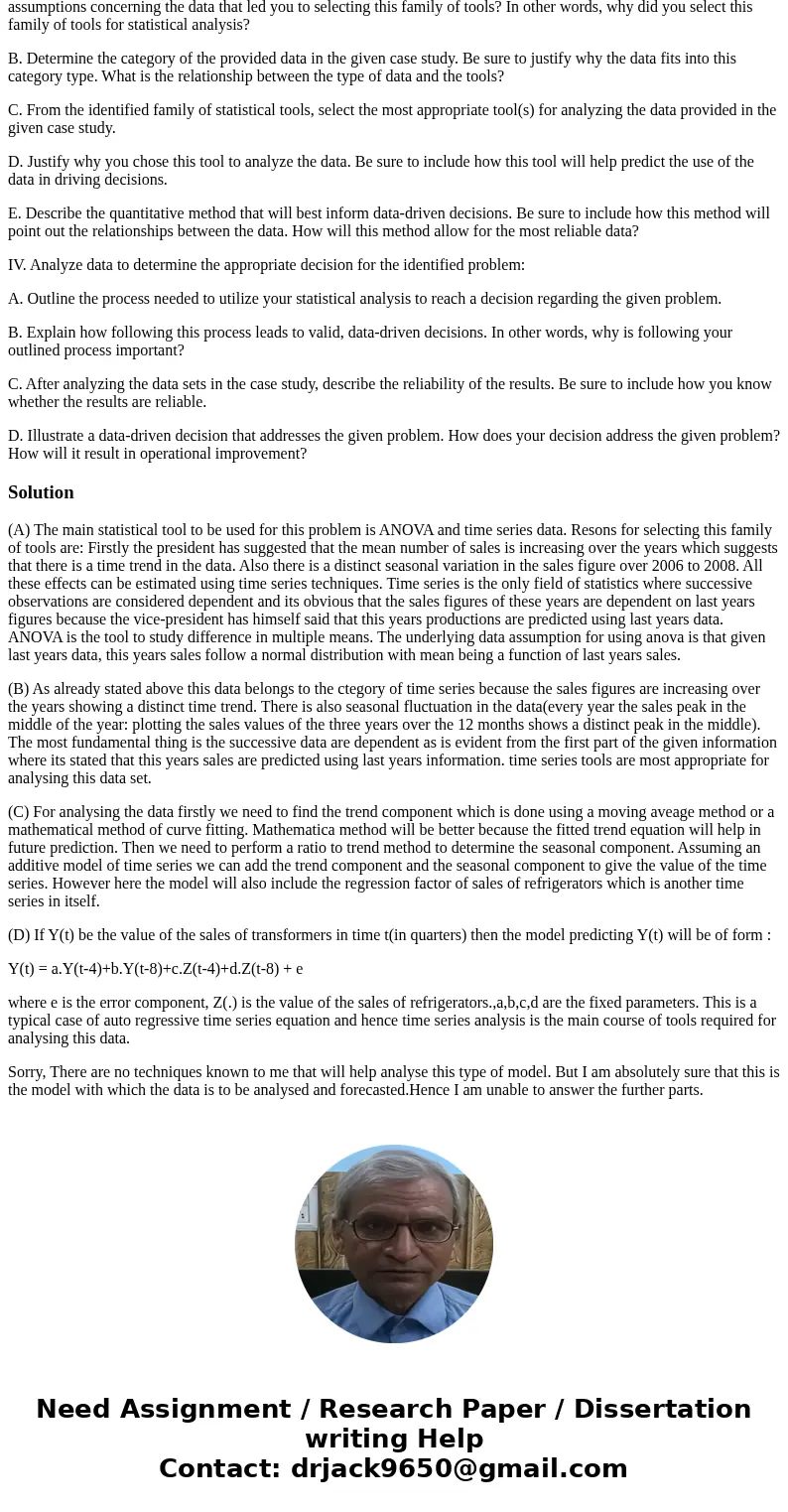Vicepresident Arun Mittra speculates We have always estimate
Vice-president Arun Mittra speculates: We have always estimated how many transformers will be needed to meet demand. The usual method is to look at the sales figures of the last two to three months and also the sales figures of the last two years in the same month. Next make a guess as to how many transformers will be needed. Either we have too many transformers in stock, or there are times when there are not enough to meet our normal production levels. It is a classic case of both understocking and overstocking.
Ratnaparkhi, operations head, has been given two charges by Mittra. First, to develop an analysis of the data and present a report with recommendations. Second, “to come up with a report that even a lower grade clerk in stores should be able to fathom and follow.”
In an effort to develop a report that is understood by all, Ratnaparkhi decides to provide incremental amounts of information to his operations manager, who is assigned the task of developing the complete analyses.
A-Cat Corporation is committed to the pursuit of a robust statistical process control (quality control) program to monitor the quality of its transformers. Ratnaparkhi, aware that the construction of quality control charts depends on means and ranges, provides the following descriptive statistics for 2006 (from Exhibit 1).
2006
Mean 801.1667
Standard Error 24.18766
Median 793
Mode 708
Standard Deviation 83.78851
Sample Variance 7020.515
Kurtosis -1.62662
Skewness 0.122258
Range 221
Minimum 695
Maximum 916
Sum 9614
Count 12
The operations manager is assigned the task of developing descriptive statistics for the remaining years, 2007–2010, that are to be submitted to the quality control department.
A-Cat’s president asks Mittra, his vice-president of operations, to provide the sales department with an estimate of the mean number of transformers that are required to produce voltage regulators. Mittra, recalling the product data from 2006, which was the last year he supervised the production line, speculates that the mean number of transformers that are needed is less than 745 transformers. His analysis reveals the following:
t = 2.32
p = .9798
This suggests that the mean number of transformers needed is not less than 745 but at least 745 transformers. Given that Mittra uses older (2006) data, his operations manager knows that he substantially underestimates current transformers requirements. She believes that the mean number of transformers required exceeds 1000 transformers and decides to test this using the most recent (2010) data.
Initially, the operations manager possessed only data for years 2006 to 2008. However, she strongly believes that the mean number of transformers needed to produce voltage regulators has increased over the three-year period. She performs a one-way analysis of variance (ANOVA) analysis that follows:
2006 2007 2008
779 845 857
802 739 881
818 871 937
888 927 1159
898 1133 1072
902 1124 1246
916 1056 1198
708 889 922
695 857 798
708 772 879
716 751 945
784 820 990
Anova: Single Factor
SUMMARY
Groups Count Sum Average Variance
2006 12 9614 801.1667 7020.515
2007 12 10784 898.6667 18750.06
2008 12 11884 990.3333 21117.88
ANOVA
Source of Variation SS df MS F P-value F crit
Between Groups 214772.2 2 107386.1 6.870739 0.003202 3.284918
Within Groups 515773 33 15629.48
Total 730545.2 35
The results (F = 6.871 and p = 0.003202) suggest that indeed the mean number of transformers has changed over the period 2006–2008. Mittra has now provided her with the remaining two years of data (2009 and 2010) and would like to know if the mean number of transformers required has changed over the period 2006–2010.
Finally, the operations manager is tasked with developing a model for forecasting transformer requirements based on sales of refrigerators. The table below summarizes sales of refrigerators and transformer requirements by quarter for the period 2006–2010, which are extracted from Exhibits 2 and 1 respectively.
Sales of Refrigerators Transformer Requirements
3832 2399
5032 2688
3947 2319
3291 2208
4007 2455
5903 3184
4274 2802
3692 2343
4826 2675
6492 3477
4765 2918
4972 2814
5411 2874
7678 3774
5774 3247
6007 3107
6290 2776
8332 3571
6107 3354
6792 3513
III. Identify statistical tools and methods to collect data:
A. Identify the appropriate family of statistical tools that you will use to perform your analysis. What are your statistical assumptions concerning the data that led you to selecting this family of tools? In other words, why did you select this family of tools for statistical analysis?
B. Determine the category of the provided data in the given case study. Be sure to justify why the data fits into this category type. What is the relationship between the type of data and the tools?
C. From the identified family of statistical tools, select the most appropriate tool(s) for analyzing the data provided in the given case study.
D. Justify why you chose this tool to analyze the data. Be sure to include how this tool will help predict the use of the data in driving decisions.
E. Describe the quantitative method that will best inform data-driven decisions. Be sure to include how this method will point out the relationships between the data. How will this method allow for the most reliable data?
IV. Analyze data to determine the appropriate decision for the identified problem:
A. Outline the process needed to utilize your statistical analysis to reach a decision regarding the given problem.
B. Explain how following this process leads to valid, data-driven decisions. In other words, why is following your outlined process important?
C. After analyzing the data sets in the case study, describe the reliability of the results. Be sure to include how you know whether the results are reliable.
D. Illustrate a data-driven decision that addresses the given problem. How does your decision address the given problem? How will it result in operational improvement?
Solution
(A) The main statistical tool to be used for this problem is ANOVA and time series data. Resons for selecting this family of tools are: Firstly the president has suggested that the mean number of sales is increasing over the years which suggests that there is a time trend in the data. Also there is a distinct seasonal variation in the sales figure over 2006 to 2008. All these effects can be estimated using time series techniques. Time series is the only field of statistics where successive observations are considered dependent and its obvious that the sales figures of these years are dependent on last years figures because the vice-president has himself said that this years productions are predicted using last years data. ANOVA is the tool to study difference in multiple means. The underlying data assumption for using anova is that given last years data, this years sales follow a normal distribution with mean being a function of last years sales.
(B) As already stated above this data belongs to the ctegory of time series because the sales figures are increasing over the years showing a distinct time trend. There is also seasonal fluctuation in the data(every year the sales peak in the middle of the year: plotting the sales values of the three years over the 12 months shows a distinct peak in the middle). The most fundamental thing is the successive data are dependent as is evident from the first part of the given information where its stated that this years sales are predicted using last years information. time series tools are most appropriate for analysing this data set.
(C) For analysing the data firstly we need to find the trend component which is done using a moving aveage method or a mathematical method of curve fitting. Mathematica method will be better because the fitted trend equation will help in future prediction. Then we need to perform a ratio to trend method to determine the seasonal component. Assuming an additive model of time series we can add the trend component and the seasonal component to give the value of the time series. However here the model will also include the regression factor of sales of refrigerators which is another time series in itself.
(D) If Y(t) be the value of the sales of transformers in time t(in quarters) then the model predicting Y(t) will be of form :
Y(t) = a.Y(t-4)+b.Y(t-8)+c.Z(t-4)+d.Z(t-8) + e
where e is the error component, Z(.) is the value of the sales of refrigerators.,a,b,c,d are the fixed parameters. This is a typical case of auto regressive time series equation and hence time series analysis is the main course of tools required for analysing this data.
Sorry, There are no techniques known to me that will help analyse this type of model. But I am absolutely sure that this is the model with which the data is to be analysed and forecasted.Hence I am unable to answer the further parts.




 Homework Sourse
Homework Sourse